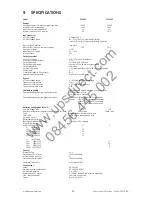
4.4.1 On
bypass
The UPS is equipped with an automatic bypass switch. This switch automatically transfers the load to the
mains if the UPS is unable to deliver the demanded output power due to overload or overtemperature. If all 5
load LEDs are illuminated, bypass operation is caused by an overload. If only first load LED is illuminated,
bypass operation is caused by overtemperature (see 4.4.8 tab .1).
The UPS will switch back to normal operation when the overload has been removed or the temperature has
dropped below alarm level.
If a power failure occurs during bypass operation, the UPS will switch to battery if possible, otherwise
output power is lost
.
4.4.2 On
battery
In normal operation conditions, if a mains failure occurs, the UPS uses the energy stored in the batteries to
supply the load.
The runtime capacity LED bar will show the remaining time (see 4.1).
For further information about runtime refer to chapter 9, Battery runtime.
The UPS will shutdown:
•
After the batteries have been discharged (automatic restart if enabled), or
•
If keypad ‘UPS off’ is pressed (restart via front panel required), or
•
If a ‘UPS shutdown’ command is given by the computer (via UPS monitoring software). Restart
depends on the setting of “auto-restart” function (see 4.4.13).
4.4.3
Battery low (end of runtime)
If during battery operation the buzzer starts beeping every 5 seconds and the first LED of the battery
charge bar starts blinking the batteries are nearly discharged: the remaining runtime is less than 2 minutes
(default setting, adjustable via the UPS monitoring software). Controlled shutdown of any computer
equipment is absolutely necessary when this alarm is raised.
If the UPS operates at 100% load, the shutdown procedure should be completed within 2 minutes after the
‘battery low’ alarm started. If only part of the output capacity of the UPS is used this period can be longer, with
aged batteries this period can be shorter.
When the batteries are fully discharged, the UPS is no longer able to supply the connected equipment and
eventually
output power is lost.
4.4.4
Bypass out of limits
The mains voltage or mains frequency are outside bypass tolerance but inside UPS input tolerance (see
chapter 9). Bypass operation is inhibited: if for whatever reason the UPS is not able to deliver the required
output,
output power is lost
. If the input frequency is often out of tolerance – during which bypass operation
is inhibited and an alarm is generated – it may be useful to disable bypass function (via UPS monitoring
software) after which the unit operates as a UPS without automatic bypass switch.
NOTE
The unit can be used as frequency converter: the input frequency range is 47.5-63Hz, the
output frequency is selectable 50/60 Hz, via UPS monitoring software.
If the unit is used in this configuration, the bypass function is no longer available.
4.4.5 Overload
The demanded power exceeds the nominal capacity of the UPS. The “overload warning” alarm occurs when
the load exceeds 150% the UPS will immediately switch to bypass, assuming that the conditions for a transfer
to bypass are fulfilled.
If an overload condition between 110-150% persists, the UPS will also switch to bypass operation. In both
conditions the “overload” alarm (see 4.4.8 tab. 1) is generated.
During an overload the UPS may automatically switch off within a few minutes (load dependent) and output
power is lost:
•
if a transfer to bypass is inhibited (see section 4.4.4), or
•
if the bypass function has been disabled (see section 4.4.4), or
•
if the UPS operates on battery (see section 4.4.2).
To avoid these problems, be absolutely certain that the power demand of the protected equipment is within
the limits of the UPS.
modifications reserved
17
User manual GT Series 6 - 10 kVA UPS 1.0 (GB)
www.upsdirect.com
08456
445
002









































